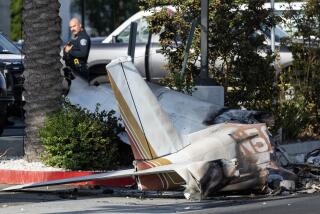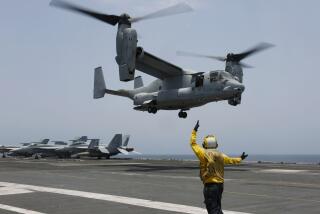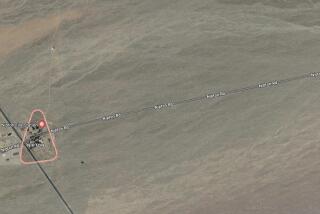North Carolina Crash Is Second in a Month for Marine Harrier Jet
For the second time in a month and the 152nd time in 34 years of flight, a Marine Corps Harrier attack jet has crashed during a noncombat mission, this time in heavily forested eastern North Carolina.
As in each of the 11 most recent crashes, the pilot in the doomed plane ejected Thursday evening without suffering significant injuries. He landed in a wooded area near the southern end of Pamlico Sound, not far from the plane’s base in Cherry Point, N.C., said Lt. Brad Avots, a Marine Corps spokesman.
“As it flew over, the engine started popping real loud, five or six times, and a big flame came out of the back,” said Pamlico County Sheriff Billy E. Sawyer Jr., who witnessed the Harrier’s descent at 6:10 p.m. from a field behind his house. “Then the pilot ejected and the plane crashed.”
The pilot, whose name has not been released, was treated briefly at a base hospital, Avots said.
The North Carolina crash came one month after a Harrier pilot punched out of his plane over Yuma, Ariz., and watched it nose-dive into the yards of several suburban homes. The plane was carrying four 500-pound bombs and 300 rounds of ammunition, but the explosives did not detonate. The Arizona crash and ensuing fire damaged several houses, leaving a 21-year-old nursing student with partial hearing loss.
The student, Stacey R. Pavlak, said the tail section landed in her family’s swimming pool, a few feet from the bedroom where she was resting.
“There was a huge explosion right behind me,” Pavlak said. “It was the loudest thing I’ve ever heard in my life. And then there was just fire. I could hear popping, like a machine gun, from the ammunition going off.”
The Harrier, renowned for its ability to take off and land vertically, has long been the military’s most dangerous airplane. Bedeviled by recurring mechanical problems and maintenance glitches, it has amassed the highest rate of major accidents of any armed forces plane.
Forty-five Marines have died in the single-seat jet, with the last fatalities coming in 2001. More than one-third of the fleet has been lost to crashes. The planes that went down in the last month cost taxpayers at least $24 million apiece. The Harrier’s engine is made by Rolls-Royce and its airframe by McDonnell Douglas Corp.
In December 2002, The Times published a series of stories showing that many of the plane’s accidents were caused by problems that had been known to Marine Corps officials for years. Since the series, nine more Harriers have been lost in noncombat accidents. The causes of many of the accidents, including the two this summer, remain under investigation.
In 2003, Congressional leaders won a commitment from the Marines to provide more flight training hours for Harrier pilots. Early last year, Rep. Duncan Hunter (R-El Cajon), chairman of the House Armed Services Committee, announced the creation of a task force headed by Rep. Howard P. “Buck” McKeon (R-Santa Clarita) to examine the five crashes in 2003.
Though the Harrier’s annual mishap rate had declined recently, this week’s crash was likely to bring the rate close to its lifetime average, which was well above the rates for other attack and fighter planes.
Given its record in training and in previous combat, the Harrier has stood up remarkably well under the punishing flying conditions of Afghanistan and Iraq, Marine Corps officials have said. The planes flew about 4,000 sorties during the conflicts without losing a plane to either enemy fire or mechanical failure.
In the Persian Gulf War of 1991, five Harriers were shot down. But design and technological improvements have since enabled the plane to fly at higher altitudes during bombing runs, making it less vulnerable to heat-seeking missiles.
Stephen E. Pavlak, Stacey’s father and the owner of the house damaged by the Arizona crash, said that as a former Army helicopter pilot he could appreciate the Harrier’s technological capabilities.
“On the other hand,” said Pavlak, who holds a high-ranking civilian position at the Harrier’s base, “I would never fly in a commercial aircraft with such a notorious record, nor would I buy a car with such a reliability record.”
The Harrier fleet at Cherry Point was grounded Friday as a safety precaution, but Avots said he expected the planes to be flying again soon.
There are fewer than 150 Harriers, and Marine officials said they now expected the plane to remain in service until 2021, several years longer than previously anticipated. The plane is to be replaced by a special Marine version of the Joint Strike Fighter, which is being designed to share the Harrier’s ability to land vertically.
The Joint Strike Fighter, however, is behind schedule and over budget, with some of its problems stemming from the need to reduce weight in order to enable vertical flight. Escalating costs have forced the military branches to reduce the number of planes they plan to buy.
More to Read
Sign up for Essential California
The most important California stories and recommendations in your inbox every morning.
You may occasionally receive promotional content from the Los Angeles Times.










